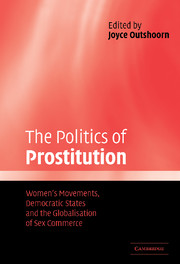 The Politics of Prostitution
The Politics of Prostitution Book contents
- Frontmatter
- Contents
- List of figures
- List of tables
- Notes on contributors
- Preface
- 1 Introduction: prostitution, women's movements and democratic politics
- 2 The women's movement and prostitution politics in Australia
- 3 Taxes, rights and regimentation: discourses on prostitution in Austria
- 4 Prostitution policies in Britain, 1982–2002
- 5 Prostitution as public nuisance: prostitution policy in Canada
- 6 Towards a new prohibitionism? State feminism, women's movements and prostitution policies in Finland
- 7 Prostitute movements face elite apathy and gender-biased universalism in France
- 8 The politics of prostitution and trafficking of women in Israel
- 9 Italy: the never-ending debate
- 10 Voluntary and forced prostitution: the ‘realistic approach’ of the Netherlands
- 11 State feminism and central state debates on prostitution in post-authoritarian Spain
- 12 Criminalising the john – a Swedish gender model?
- 13 The invisible issue: prostitution and trafficking of women and girls in the United States
- 14 Comparative prostitution politics and the case for state feminism
- Appendix 1 Independent variable indicators
- Appendix 2 Worksheets
- References
- Index
5 - Prostitution as public nuisance: prostitution policy in Canada
Published online by Cambridge University Press: 22 September 2009
- Frontmatter
- Contents
- List of figures
- List of tables
- Notes on contributors
- Preface
- 1 Introduction: prostitution, women's movements and democratic politics
- 2 The women's movement and prostitution politics in Australia
- 3 Taxes, rights and regimentation: discourses on prostitution in Austria
- 4 Prostitution policies in Britain, 1982–2002
- 5 Prostitution as public nuisance: prostitution policy in Canada
- 6 Towards a new prohibitionism? State feminism, women's movements and prostitution policies in Finland
- 7 Prostitute movements face elite apathy and gender-biased universalism in France
- 8 The politics of prostitution and trafficking of women in Israel
- 9 Italy: the never-ending debate
- 10 Voluntary and forced prostitution: the ‘realistic approach’ of the Netherlands
- 11 State feminism and central state debates on prostitution in post-authoritarian Spain
- 12 Criminalising the john – a Swedish gender model?
- 13 The invisible issue: prostitution and trafficking of women and girls in the United States
- 14 Comparative prostitution politics and the case for state feminism
- Appendix 1 Independent variable indicators
- Appendix 2 Worksheets
- References
- Index
Summary
Introduction
Since 1972 prostitution law in Canada has had the dubious distinction of making it legal to ‘be’ a prostitute but next to impossible to actually engage in prostitution-related activity. While many Western countries have moved away from stricter criminal laws against prostitution, Canada has moved in quite the opposite direction with the maintenance of anti-brothel laws and the introduction of laws aimed at the street-level trade, a small percentage of prostitution-related activities (Davis and Schaffer 1994: I). Until the late 1970s, street prostitution was dealt with under the vagrancy provisions of the Criminal Code, which allowed for the arrest of ‘common prostitutes’ found in public places. Following changes in the interpretation of the law in the late 1970s that made it more difficult to arrest prostitutes, police forces and residents' groups began to campaign for tougher laws to control street solicitation. Feminist attempts to lobby for decriminalisation of prostitution (i.e. its complete or near complete removal from the Criminal Code) have continued to meet strong resistance from these groups. The current ‘anti-communications’ law, which makes communication for the purpose of prostitution illegal, is technically more gender equitable than in the past – in that it addresses both prostitutes and clients and includes both male and female prostitutes. However, it fails to address the underlying gender inequity that results from the criminalisation (i.e. using criminal sanctions against activities associated with prostitution) of prostitute women. Women in prostitution continue to be disproportionately charged by police (Shaver 1993: 154–5).
- Type
- Chapter
- Information
- The Politics of ProstitutionWomen's Movements, Democratic States and the Globalisation of Sex Commerce, pp. 83 - 102Publisher: Cambridge University PressPrint publication year: 2004
- 2
- Cited by


